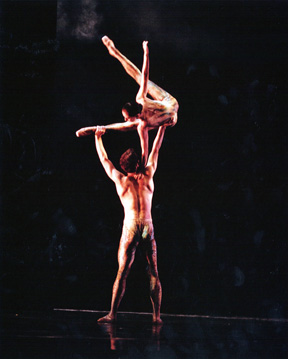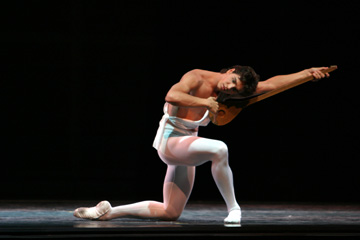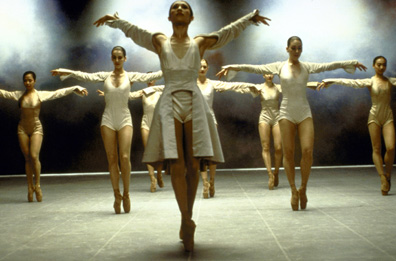Canadian Ballet
Apollo and three ballets by James Kudelka
National Ballet of Canada
Zellerbach Hall, Berkeley
Presented by Cal Performances
Thursday, September 30, 2004
By
Paul Parish
copyright
© 2004 by Paul
Parish
published October 4, 2004
 The
National Ballet of Canada returned to the Bay Area for the first time
in thirteen years last week for concerts in the 2200-seat Zellerbach Hall
at UC Berkeley. The house was not full on Thursday night, but that was
the evening of the first Presidential debates, which Berkeleyans would
feel sinful if they’d missed. The audience was studded with university
dignitaries—the new chancellor is Canadian—and the dance world
was also well-represented. San Francisco Ballet's artistic director Helgi
Tomasson was in the house, as well as the well-loved ballerina Evelyn
Cisneros, who had danced in several ballets choreographed for SFB by James
Kudelka, who has been associated with the Canadian company since 1972,
and its director since 1996.
The
National Ballet of Canada returned to the Bay Area for the first time
in thirteen years last week for concerts in the 2200-seat Zellerbach Hall
at UC Berkeley. The house was not full on Thursday night, but that was
the evening of the first Presidential debates, which Berkeleyans would
feel sinful if they’d missed. The audience was studded with university
dignitaries—the new chancellor is Canadian—and the dance world
was also well-represented. San Francisco Ballet's artistic director Helgi
Tomasson was in the house, as well as the well-loved ballerina Evelyn
Cisneros, who had danced in several ballets choreographed for SFB by James
Kudelka, who has been associated with the Canadian company since 1972,
and its director since 1996.
And those of us who were simply in the audience had many reasons to be glad we were there.
The evening met Balanchine's first requirement for a good concert—the music was sensational. If you'd kept your eyes closed, you could have had a satisfying evening. The bill consisted of Stravinsky's "Apollon Musagete," Vaughan-Williams' "Variations on a Theme of Thomas Tallis," and Vivaldi's "Four Seasons," played beautifully by the Berkeley symphony, conducted with sweep and sensitivity by the Ballet's music director, Ormsby Wilkins. The violin soloist for the Vivaldi, Fujiko Imajishi, got a strong ovation, fully deserved.
"Apollo" was gloriously danced by Guillaume Côté, though the other performers were not at all up to his standard. Balanchine's ballet was staged for NBC by Ib Andersen, himself a famous Apollo. The imbalance of forces reminded me of the way in which San Francisco Ballet's "Apollo," set by Jacques d'Amboise and seen here just last Spring during the SFB Balanchine celebration, was equally heavily weighted toward the male star. Both stagings used the entire score, both revealed just how powerful Leto's brief solo can be, and how literally awe-inspiring the ascent to Olympus can be at the end. And both left the ballerinas looking very dull—especially Terpsichore. One wonders if the ballet needs to be set by Suzanne Farrell for the Muse of dancing to really seem to be the embodiment of the dance—all the steps are there, but none of the nuances, the length at the front of the hip as she swivels on pointe from fourth to second to fourth, all that intrigue one knows, or feels, or believes, or simply desires, to be there—seems to be absent when a former Apollo sets the ballet. The subtle pelvic thrusts—as when Terpsichore does a kind of jazz square around herself. In the Canadian version the thrust was displaced into the shoulders; she swayed quite a lot, like a palm tree in a wind, but it seemed like the wrong part of the body was doing the bending.
The Canadians' "Apollo" did everybody credit, though the muses were not great —well, Rebekah Rimsay as the muse who "speaks from a full-flowing stomach" (to quote “King Lear”) made an unusually strong impression—but then, did anybody expect their Balanchine to be great?

But it was in the ballets of James Kudelka, which took up the rest of the evening, that we all expected to see what the Canadians have uniquely to offer —and there we were certainly not disappointed.
After intermission Mr. Côté again danced wonderfully in a world-premiere solo, "Chacony" (to Henry Purcell's "Chacony in G Minor for Strings"), which reminded me (in a good way) of Limon's "The Unsung." The stage was mostly dark, against which, upstage, stood out a nexus of ribbons, like a sketch of a spider-web, or some kind of trap; the man wore a fringed-buckskin costume, dark green (designed by Marjory Fielding and Christopher Read). It fit his body closely and suggested the old west. The character of the dance was heroic—perhaps this was perhaps a test of manhood, a rite of passage; he certainly had some fears to face, an ordeal to abide. The most memorable step was a kind of grand jete that did not leave the ground—the front leg would kick high, which would lift him high onto the standing foot and drag him forward, and he'd cover the length of the stage in this kind of desperate lunge, and then collapse into a swastika on the ground, fully turned out and totally flat on the floor. At one point, he twigged the threads of the web, which vibrated menacingly. Mr. Côté balanced the technical and the expressive aspects of he movement in a fascinating way, showing the technique at a virtuoso level without making it seem a mere set of tricks, but still without on the other hand making a Limonesque claim to owning this ritual material. I found myself respecting the enterprise.
The ballet reminded me of the works Mr. Kudelka has created for San Francisco Ballet, especially the heroic solo once danced by Eric Hoisington to the Scherzo of Brahms's Fourth Symphony. It was a gigantic ballet, the entire first movement a pas de deux, which was not entirely successful. But the scherzo was astounding—partly because Mr. Hoisington brought to it a magnificence of spirit, a colossal outpouring of energy and a heroic muscularity of Rodinesque proportions that made it a kind of agon, a Romantic struggle with the self that actually realized the heroic tensions in the music. (It made Mr. Hoisington a star in San Francisco, and he was always quick to mention his gratitude to Kudelka for giving him such an opportunity.)
“Chacony” was followed by a pause and seemed a newly composed prelude to the ballet which followed, "there below," had a similarly Rodinesque heroic muscularity. The piece, set for five couples in unitards to the aforementioned Vaughan Williams, seemed Grahamesque in its plastique and in its ambitions—to be a kind of temple dance, very contortionist, with exotic extensions, huge lifts, very difficult partnering which the men made look as if it called on all their devotion. The women were often in positions like in Ashton's "Monotones," on pointe but bent over, with one knee drawn up, turned-in passé, and everything would open out from there. They danced it in all sincerity. I admired them but could not get involved. Did it look old-fashioned? I found myself thinking… of Ruth St. Dennis, of Graham, of the movement in the 60's to use dance as a medium to access altered states of consciousness, and attempts like Ashton's "Monotones" (and Ronn Guidi's fine version of "Monotones" for the Oakland Ballet) to make ballets that captured some of the weight and importance of trance and erotic transport. “there below" felt like a museum piece... more's the pity.
 The
evening closed with a stirring and very satisfying West-coast premiere
of Mr. Kudelka's "Four Seasons," composed in a much more classical
idiom, following a man (Aleksander Antonijevic) through his life. Each
section had a different ballerina and its own character—which prepared
us, without letting us guess that it would happen, for when he died at
the end. The Winter section was a powerful coup de theatre that found
him dancing with old people. The fourth ballerina might have been his
mother (I suddenly found myself flashing on Gena Rowlands in the movie
"An Early Frost; "the feeling was very similar). I felt tears
start to my eyes, to see older dancers moving so beautifully—the
program isn’t clear, but they were (I think) Victoria Bertram, Lorna
Geddes (a ballet mistress for the company), and guest artists Tomas Schramek
and Hazaros Surmeyan.
The
evening closed with a stirring and very satisfying West-coast premiere
of Mr. Kudelka's "Four Seasons," composed in a much more classical
idiom, following a man (Aleksander Antonijevic) through his life. Each
section had a different ballerina and its own character—which prepared
us, without letting us guess that it would happen, for when he died at
the end. The Winter section was a powerful coup de theatre that found
him dancing with old people. The fourth ballerina might have been his
mother (I suddenly found myself flashing on Gena Rowlands in the movie
"An Early Frost; "the feeling was very similar). I felt tears
start to my eyes, to see older dancers moving so beautifully—the
program isn’t clear, but they were (I think) Victoria Bertram, Lorna
Geddes (a ballet mistress for the company), and guest artists Tomas Schramek
and Hazaros Surmeyan.
Each season was engaging in its way—the corps of the spring section
had wonderful passages of flying jetes with the feet close together, though
other passages were fussy and only a great deal of rehearsal—they
looked VERY well-rehearsed—could have kept it from looking ragged.
“Summer” was sensational. It was our first sight of Greta
Hodgkinson, a first-rate classical dancer, mistress of many effects and
magnificently able to keep them up her sleeve. She was the only female
dancer who moved with freedom and boldness—the rest of them, very
well-schooled, beautifully disciplined, almost phenomenally neat, had
a "decency" about them that reminded me of what Denby didn't
like about the Royal Ballet. The women ALL have a remarkable gift for
stillness, and can remain utterly motionless on pointe—for whole
measures—as the music accumulates around them, so that when they
do move again, it's something you've been waiting for and find very satisfying.
But Ms. Hodgkinson had that and also a mystery about her—an allegro mystery, but a mystery all the same. She's technically superb, but with control she has also the gift of surprise—I was on the edge of my seat throughout "Summer." She took one spectacular fall, landing beautifully on her hands, in a high arabesque with a sort of grand plié in her elbows, that literally shocked the audience—no-one saw it coming, but it totally fit the music (and people who know the ballet said it was no accident). She performed Terpsichore on alternate nights, and I deeply regret that I was not able to get back to see them again to see her interpretation of that role. I think she has greatness in her.
Photos:
First: Dancers of the National Ballet of Canada in "there below."
Second: Guillaume Côté "Apollo". Photo by
Brian Zinger.
Third: Dancers of NBoC in "The Four Seasons."
www.danceviewtimes.com
Volume 2, No. 37
October 4, 2004
Copyright
©2004 by Paul Parish
|
|
|